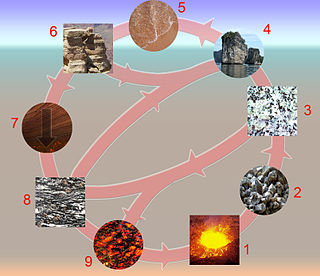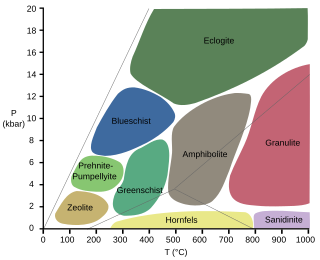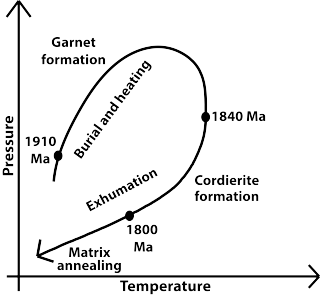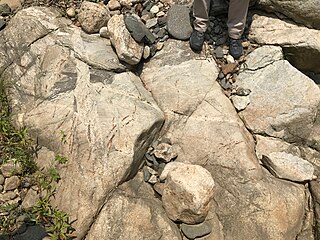Related Research Articles

Schist is a medium-grained metamorphic rock showing pronounced schistosity. This means that the rock is composed of mineral grains easily seen with a low-power hand lens, oriented in such a way that the rock is easily split into thin flakes or plates. This texture reflects a high content of platy minerals, such as micas, talc, chlorite, or graphite. These are often interleaved with more granular minerals, such as feldspar or quartz.

The Alps form part of a Cenozoic orogenic belt of mountain chains, called the Alpide belt, that stretches through southern Europe and Asia from the Atlantic all the way to the Himalayas. This belt of mountain chains was formed during the Alpine orogeny. A gap in these mountain chains in central Europe separates the Alps from the Carpathians to the east. Orogeny took place continuously and tectonic subsidence has produced the gaps in between.

Subduction is a geological process in which the oceanic lithosphere and some continental lithosphere is recycled into the Earth's mantle at convergent boundaries. Where the oceanic lithosphere of a tectonic plate converges with the less dense lithosphere of a second plate, the heavier plate dives beneath the second plate and sinks into the mantle. A region where this process occurs is known as a subduction zone, and its surface expression is known as an arc-trench complex. The process of subduction has created most of the Earth's continental crust. Rates of subduction are typically measured in centimeters per year, with rates of convergence as high as 11 cm/year.

Coesite is a form (polymorph) of silicon dioxide (SiO2) that is formed when very high pressure (2–3 gigapascals), and moderately high temperature (700 °C, 1,300 °F), are applied to quartz. Coesite was first synthesized by Loring Coes, Jr., a chemist at the Norton Company, in 1953.

Serpentinization is a hydration and metamorphic transformation of ferromagnesian minerals, such as olivine and pyroxene, in mafic and ultramafic rock to produce serpentinite. Minerals formed by serpentinization include the serpentine group minerals, brucite, talc, Ni-Fe alloys, and magnetite. The mineral alteration is particularly important at the sea floor at tectonic plate boundaries.

The rock cycle is a basic concept in geology that describes transitions through geologic time among the three main rock types: sedimentary, metamorphic, and igneous. Each rock type is altered when it is forced out of its equilibrium conditions. For example, an igneous rock such as basalt may break down and dissolve when exposed to the atmosphere, or melt as it is subducted under a continent. Due to the driving forces of the rock cycle, plate tectonics and the water cycle, rocks do not remain in equilibrium and change as they encounter new environments. The rock cycle explains how the three rock types are related to each other, and how processes change from one type to another over time. This cyclical aspect makes rock change a geologic cycle and, on planets containing life, a biogeochemical cycle.

The Austroalpine nappes are a geological nappe stack in the European Alps. The Alps contain three such stacks, of which the Austroalpine nappes are structurally on top of the other two. The name Austroalpine means Southern Alpine, because these nappes crop out mainly in the Eastern Alps.

The North China Craton is a continental crustal block with one of Earth's most complete and complex records of igneous, sedimentary and metamorphic processes. It is located in northeast China, Inner Mongolia, the Yellow Sea, and North Korea. The term craton designates this as a piece of continent that is stable, buoyant and rigid. Basic properties of the cratonic crust include being thick, relatively cold when compared to other regions, and low density. The North China Craton is an ancient craton, which experienced a long period of stability and fitted the definition of a craton well. However, the North China Craton later experienced destruction of some of its deeper parts (decratonization), which means that this piece of continent is no longer as stable.

The Haast Schist, which contains both the Alpine and Otago Schist, is a metamorphic unit in the South Island of New Zealand. It extends from Central Otago, along the eastern side of the Alpine Fault to Cook Strait. There are also isolated outcrops of the Haast Schist within the central North Island. The schists were named after Haast Pass on the West Coast. The Haast Schist can be divided geographically from north to south into the Kaimanawa, Terawhiti, Marlborough, Alpine, Otago and Chatham schist.
In geology ultrahigh-temperature metamorphism (UHT) is extreme crustal metamorphism with metamorphic temperatures exceeding 900 °C. Granulite-facies rocks metamorphosed at very high temperatures were identified in the early 1980s, although it took another decade for the geoscience community to recognize UHT metamorphism as a common regional phenomenon. Petrological evidence based on characteristic mineral assemblages backed by experimental and thermodynamic relations demonstrated that Earth's crust can attain and withstand very high temperatures (900–1000 °C) with or without partial melting.
Partial melting is the phenomenon that occurs when a rock is subjected to temperatures high enough to cause certain minerals to melt, but not all of them. Partial melting is an important part of the formation of all igneous rocks and some metamorphic rocks, as evidenced by a multitude of geochemical, geophysical and petrological studies.
A whiteschist is an uncommon metamorphic rock formed at high to ultra-high pressures. It has the characteristic mineral assemblage of kyanite + talc, responsible for its white colour. The name was introduced in 1973 by German mineralogist and petrologist Werner Schreyer. This rock is associated with the metamorphism of some pelites, evaporite sequences or altered basaltic or felsic intrusions. Whiteschists form in the MgO–Fe
2O
3–Al
2O
3–SiO
2–H
2O (MFASH) system. Rocks of this primary chemistry are extremely uncommon and they are in most cases thought to be the result of metasomatic alteration, with the removal of various mobile elements.

Eclogitization is the tectonic process in which the high-pressure, metamorphic facies, eclogite, is formed. This leads to an increase in the density of regions of Earth's crust, which leads to changes in plate motion at convergent boundaries.

High pressure terranes along the ~1200 km long east-west trending Bangong-Nujiang suture zone (BNS) on the Tibetan Plateau have been extensively mapped and studied. Understanding the geodynamic processes in which these terranes are created is key to understanding the development and subsequent deformation of the BNS and Eurasian deformation as a whole.

A subduction zone is a region of the Earth's crust where one tectonic plate moves under another tectonic plate; oceanic crust gets recycled back into the mantle and continental crust gets created by the formation of arc magmas. Arc magmas account for more than 20% of terrestrially produced magmas and are produced by the dehydration of minerals within the subducting slab as it descends into the mantle and are accreted onto the base of the overriding continental plate. Subduction zones host a unique variety of rock types created by the high-pressure, low-temperature conditions a subducting slab encounters during its descent. The metamorphic conditions the slab passes through in this process creates and destroys water bearing (hydrous) mineral phases, releasing water into the mantle. This water lowers the melting point of mantle rock, initiating melting. Understanding the timing and conditions in which these dehydration reactions occur, is key to interpreting mantle melting, volcanic arc magmatism, and the formation of continental crust.

Timothy John Barrington Holland is a petrologist and Emeritus Professor in the Department of Earth Sciences at the University of Cambridge.

Eoarchean geology is the study of the oldest preserved crustal fragments of Earth during the Eoarchean era from 4 to 3.6 billion years ago. Major well-preserved rock units dated Eoarchean are known from three localities, the Isua Greenstone Belt in Southwest Greenland, the Acasta Gneiss in the Slave Craton in Canada, and the Nuvvuagittuq Greenstone Belt in the eastern coast of Hudson Bay in Quebec. From the dating of rocks in these three regions scientists suggest that plate tectonics could go back as early as Eoarchean.

The Pressure-Temperature-time path is a record of the pressure and temperature (P-T) conditions that a rock experienced in a metamorphic cycle from burial and heating to uplift and exhumation to the surface. Metamorphism is a dynamic process which involves the changes in minerals and textures of the pre-existing rocks (protoliths) under different P-T conditions in solid state. The changes in pressures and temperatures with time experienced by the metamorphic rocks are often investigated by petrological methods, radiometric dating techniques and thermodynamic modeling.

Tonalite–trondhjemite–granodiorite (TTG) rocks are intrusive rocks with typical granitic composition but containing only a small portion of potassium feldspar. Tonalite, trondhjemite, and granodiorite often occur together in geological records, indicating similar petrogenetic processes. Post Archean TTG rocks are present in arc-related batholiths, as well as in ophiolites, while Archean TTG rocks are major components of Archean cratons.

The Dharwar Craton is an Archean continental crust craton formed between 3.6-2.5 billion years ago (Ga), which is located in southern India and considered as the oldest part of the Indian peninsula.
References
- ↑ Gates, Alexander E. (2003). A to Z of earth scientists. New York: Facts on File. ISBN 9781438109190.
- ↑ ORCID. "Jane Selverstone (0000-0003-4234-4111)". orcid.org. Retrieved 2021-07-03.
- 1 2 Gates, Alexander E. (2003). A to Z of earth scientists. New York: Facts on File. ISBN 9781438109190.
- 1 2 3 "Jane Selverstone | University of New Mexico - Academia.edu". unm.academia.edu. Retrieved 2021-07-03.
- 1 2 "Selverstone". Honors Program. Retrieved 2021-07-04.
- ↑ "Jane Selverstone".
- ↑ Selverstone, J.; Spear, F. S.; Franz, G.; Morteani, G. (1 January 1984). "High-Pressure Metamorphism in the SW Tauern Window, Austria: P-T Paths from Hornblende-Kyanite-Staurolite Schists". Journal of Petrology. 25 (2): 501–531. doi:10.1093/petrology/25.2.501.
- ↑ Selverstone, J.; Morteani, G.; Staude, J.-M. (July 1991). "Fluid channelling during ductile shearing: transformation of granodiorite into aluminous schist in the Tauern Window, Eastern Alps". Journal of Metamorphic Geology. 9 (4): 419–431. Bibcode:1991JMetG...9..419S. doi:10.1111/j.1525-1314.1991.tb00536.x.
- ↑ Selverstone, Jane (December 1985). "Petrologic constraints on imbrication, metamorphism, and uplift in the SW Tauern Window, eastern Alps". Tectonics. 4 (7): 687–704. Bibcode:1985Tecto...4..687S. doi:10.1029/TC004i007p00687.
- ↑ Selverstone, Jane (2004-10-27). "Are the alps collapsing?". Annual Review of Earth and Planetary Sciences. 33 (1): 113–132. doi:10.1146/annurev.earth.33.092203.122535. ISSN 0084-6597.
- ↑ Selverstone, Jane; Sharp, Zachary D. (1 May 2015). "Chlorine isotope behavior during prograde metamorphism of sedimentary rocks". Earth and Planetary Science Letters. 417: 120–131. Bibcode:2015E&PSL.417..120S. doi:10.1016/j.epsl.2015.02.030.
- ↑ Selverstone, Jane; Sharp, Zachary D. (15 October 2011). "Chlorine isotope evidence for multicomponent mantle metasomatism in the Ivrea Zone". Earth and Planetary Science Letters. 310 (3–4): 429–440. Bibcode:2011E&PSL.310..429S. doi:10.1016/j.epsl.2011.08.034.
- ↑ ""The Discovery and Significance of Diamonds from The Alps" Topic of Lecture by Jane Selverstone". UNM Newsroom. Retrieved 2021-07-03.
- ↑ Frezzotti, Maria-Luce; Huizenga, Jan-Marten; Compagnoni, Roberto; Selverstone, Jane (October 2014). "Diamond formation by carbon saturation in C–O–H fluids during cold subduction of oceanic lithosphere" (PDF). Geochimica et Cosmochimica Acta. 143: 68–86. Bibcode:2014GeCoA.143...68F. doi:10.1016/j.gca.2013.12.022.
- ↑ Frezzotti, M. L.; Selverstone, J.; Sharp, Z. D.; Compagnoni, R. (2011). "Carbonate dissolution during subduction revealed by diamond-bearing rocks from the Alps". Nature Geoscience. 4 (10): 703–706. Bibcode:2011NatGe...4..703F. doi:10.1038/ngeo1246. ISSN 1752-0908.
- ↑ "Mineralogical Society of America - MSA Distinguished Lecturer Program". www.minsocam.org. Retrieved 2021-07-03.
- ↑ ""The Discovery and Significance of Diamonds from The Alps" Topic of Lecture by Jane Selverstone". UNM Newsroom. Retrieved 2021-07-03.
- ↑ "Jane Selverstone Honored for Promoting Women in Science" (PDF). New Mexico Network for Women in Science and Engineering. February 1, 2012.
- ↑ "Reginald Daly Lecture | AGU". www.agu.org. Retrieved 2021-07-03.
- ↑ Moss, Rebecca (January 6, 2018). "UNM meteorologist says Southwest 'on front lines … of climate change'". Santa Fe New Mexican.
- ↑ "Gutzler-Selverstone Dual Career Profile". Dual Career Couples. Retrieved 2021-07-03.
- ↑ "Jane Selverstone - Official Website". Jane Selverstone - Official Website. Retrieved 2021-07-03.